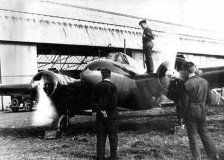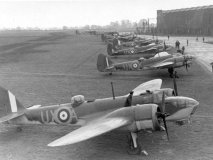
Fokker G.1
Originally flown with Hispano-Suiza radials, the G.1 was initially slow in development, after a mishap in which the prototype suffered brake failure and rammed a hangar at Schipol Airport on 4 July 1937.
A private venture by Fokker, the G.1 proved to be a sound design and attracted the attention of the Dutch Army Air Service. Changes were made to meet their requirements, which caused further delay, and the G.1 finally began to reach squadrons in mid 1939. As the aircraft went into Dutch service, export orders were placed by several European countries, though deliveries were not possible - war had broken out in 1939 and the Netherlands would need all the aircraft it could get.
When Germany occupied the Netherlands in May 1940, G.1s (armed with eight machine guns or mixed cannon/machine gun armament) made little impact against the advancing forces. The G.1s made a few bomb attacks on the invaders and shot down some German aircraft, but their own losses were high. Germany later made use of captured aircraft as trainers. Of 62 G.1s built, none has survived.
A sensation at the 1936 paris air show, the Fokker G.1 heavy fighter's twin-engined, twin-boom shape was new and innovative. The aircraft appeared to set a new standard of speed and performance. In fact, the Fokker G.1 was a transitional design, merging ageing technology of the 1930s with improved features that were to characterise World War II aircraft. Outperformed by single-seaters, the G.1 had a modest and short career.
 |
 |
 |
| Upon arrival in Finland the G.1Bs were to be fitted with two Oerlikon 20 mm (0.79 in) cannon and two 7.92 mm (0.31 in) machine guns. In 1939 all completed aircraft were kept by the Dutch. |
After four days of fighting, the Netherlands capitulated on 14 May 1940. At the Fokker factory the German invaders found two serviceable G.1As and a number of G.1Bs, originally destined for Finland. They were completed and transferred to Germany. |
The Fokker G.1 prototype, X-2, was equipped with the 559-kW (750 hp) Hispano Suiza 80-02 radial engines, which failed during testing. |
|
Fokker G.1 (Technical Specification) |
| Role |
Twin-engine heavy fighter and ground attack aircraft |
| Manufacturer |
Fokker |
| Maximum Speed |
432 kmh (268 mph) |
| Maximum Range |
1,400 km (870 miles) |
Ceiling |
9,100 meters (30,000 feet) |
Weight
Empty
Maximum Takeoff |
3,150 kg (6,930 lbs)
4,400 kg (9,680 lbs) |
Dimensions
Wingspan
Length
Height
Wing Area |
16.50 meters (54 ft 2 in)
11.50 meters (37 ft 9 in)
3.40 meters (11 ft 2 in)
35.70 square meters (381 sq ft) |
| Engines |
Two Bristol Mercury VIII radial piston engine each provides 619-kW (830-hp) |
| Armament |
Eight 7.92 mm (0.31 in) FN-Browning machine guns in the nose
One flexible 7.92 mm FN-Browning machine gun in the rear fuselage
Plus up to 300 kg (660 lbs) of bombs |
Photo Gallery
Click here to submit your photo
| Have A Passion For Aircraft? |
Subscribe to our 14 series FREE newsletter
delivered weekly on World War 2 Aircraft factfile... |
| NB:- We hate spam as much as you do, so your email address will NEVER be shared with or sold to anyone else. That's a Guarantee. |
|
|





